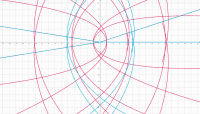In another activity, I said ln(0) was a very real thing in the complex plane. Using this, I "made" another number (lets call "u") so that e^(ui)=0, but also keep in mind e^u is not in any way equivalent. By using the value of u per rotation (essentially raising it to powers increases the number of ln(0)'s by the same amount), you can derive an equation represented by sums of (ui)^n/(n*n!). by simply graphing each individual peice (as seen in the activity), you see that this equation is essentially the exact same as (x+yi)^n, with the curves in different places. You'll notice, however, that all of the curves still retain their basic forms and shapes compared to (x+yi)^n.
This activity is just to show that what I refer to as ln(0) IS in fact a legitimate geometric quantity, in reference to complex surfaces. One of these two surfaces (not x+yi) comes directly from e^(ln(0)).
Bear in mind, that zero isn't a zero, it's an absolute value based on what I'm doing, if you really really hate what I'm saying, start there and see for yourself. Keep everything radial, and say e^(ui) is equal to the cosine of one angle, minus the sin of a completely different one, and adding them is equivalent to zero. Pretty cool ain't it?


